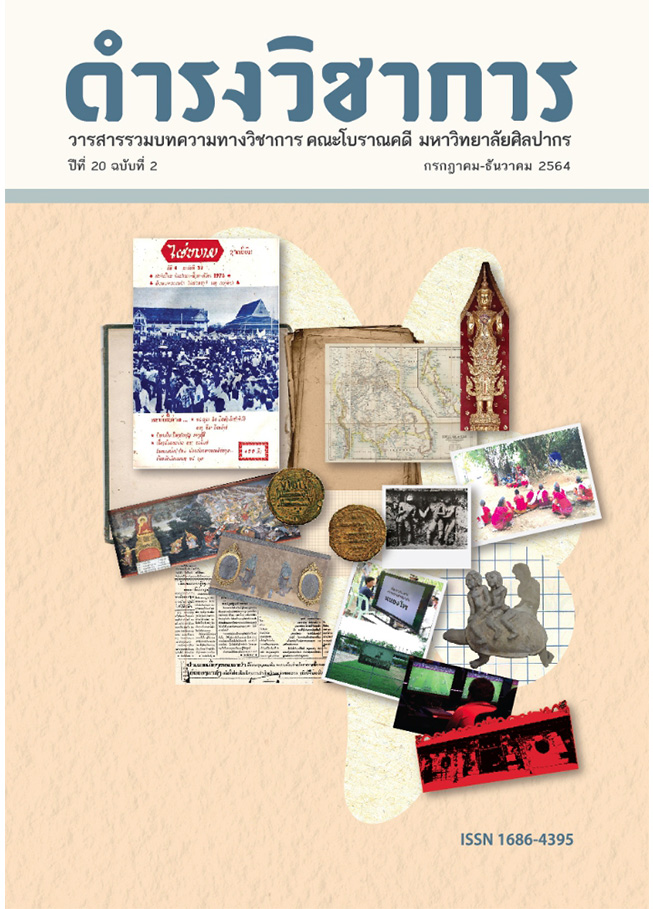Buddhist Banner, Lanna Tung Jai and Pha Chet (“the versatile cloth”): Development of Style and Continuity
Keywords:
Buddhist banner Lanna, Pha-Chet, Tai Yuan, Tai LueAbstract
A kind of Buddhist banner, called Tung Jai in Lanna, has historically been used as an offering object and for the purposes of celebration and decoration among Tai Yuan and Lue. This banner usually appeared in plain fabric with no figure. Some scholars noticed that this kind of banner is very close to Pha Chet (‘versatile cloth’) of Tai Lue and has also been used as an offering object in front of the Buddha Image in the Vihara, much like the type of banner known as Tung. This article examines the style, structure of the textiles and the techniques of both types to explain the development of styles and provide a guideline for dating these textiles. The result of the examination of the construction and motifs shows similarities between Pha Chet and Tung. However, these similarities don’t emerge until the late 20th century, which suggests that Pha Chet might have been used later than Tung, with its use restricted to the Tai Lue people.
References
ภาษาไทย
กรมศิลปากร, 2557. ตำนานมูลศาสนา. นนทบุรี: ศรีปัญญา.
จิราวรรณ กาวิละ โอคาโมโตะ และ ทรงศักดิ์ ปรางค์วัฒนากุล, 2553. “สร้างสมบุญหนุนภพหน้า.” ใน จิราวรรณ กาวิละ โอคาโมโตะ, แพททรีเซีย ชีสแมน และ ทรงศักดิ์ ปรางค์วัฒนากุล, สุนทรีย์แห่งลีลา ผืนผ้าแพรพรรณ พินิจผ้าชิ้นเด่นของพิพิธภัณฑ์ธนาคารแห่งประเทศไทย สำนักงานภาคเหนือ (หน้า 64). เชียงใหม่: นพบุรีการพิมพ์.
ทรงศักดิ์ ปรางค์วัฒนากุล, 2551. มรดกวัฒนธรรม ผ้าทอไทลื้อ. เชียงใหม่: ภาควิชาภาษาไทย คณะมนุษยศาสตร์ มหาวิทยาลัยเชียงใหม่.
________, 2558. “ผ้าทอไทลื้อ: คือชีวิตและศรัทธา.” ใน ปฐม หงส์สุวรรณ (บรรณาธิการ), ผ้าทอในวิถีไทย-ไท (หน้า 262). กรุงเทพฯ: สถาบันไทยศึกษา จุฬาลงกรณ์มหาวิทยาลัย.
________, 2559. พิพิธภัณฑ์ลื้อลายคำ สืบสานสายใยผ้าทอไทลื้อ. เชียงราย: พิพิธภัณฑ์ลื้อลายคำ.
ทรงศักดิ์ ปรางค์วัฒนากุล และ แพททรีเซีย ชีสแมน, 2538. ผ้าล้านนา ยวน ลื้อ ลาว. กรุงเทพฯ : อมรินทร์พริ้นติ้งกรุ๊ป.
น. ณ ปากน้ำ, 2544. วัดบวกครกหลวง. กรุงเทพฯ: เมืองโบราณ.
พ.นิรันดร์ อภิวฒโน (ขันธิมา), 2547. ตุงล้านนาภูมิปัญญาบรรพชน. เชียงใหม่: คณะศึกษาศาสตร์ มหาวิทยาลัยเชียงใหม่.
ภาณุพงษ์ เลาหสม, 2541. จิตรกรรมฝาผนังล้านนา. กรุงเทพฯ: เมืองโบราณ.
มัชฌิมา วีรศิลป์, 2549. “การศึกษาวรรณกรรมล้านนาเรื่องเวสสันดรชาดกสำนวนไผ่แจ้เรียวแดง.” วิทยานิพนธ์ปริญญามหาบัณฑิต คณะอักษรศาสตร์ มหาวิทยาลัยศิลปากร.
ยุพินศรี สายทอง, 2528. งานทอ. กรุงเทพฯ: โอเดียนสโตร์.
วิถี พานิชพันธ์, 2547. ผ้าและสิ่งถักทอไท. เชียงใหม่: ซิลค์เวิร์ม.
วิบูลย์ ลี้สุวรรณ, 2559. พจนานุกรมผ้าและเครื่องถักทอ. พิมพ์ครั้งที่ 2. กรุงเทพฯ: เมืองโบราณ.
วิยะดา ทองนิมิตร, 2526. วัดพระสิงห์. กรุงเทพฯ: เมืองโบราณ.
ศูนย์ส่งเสริมศิลปาชีพระหว่างประเทศ, 2556. ศตวรรษา ผ้าโบราณไท. พระนครศรีอยุธยา: ศูนย์ส่งเสริมศิลปาชีพระหว่างประเทศ.
สุชีพ ปุญญานุภาพ, 2560. พระไตรปิฎกฉบับสำหรับประชาชน. กรุงเทพฯ: มูลนิธิมหามกุฎราชวิทยาลัย.
ภาษาอังกฤษ
Bock C., 1986. Temples and elephants: Travels in Siam in 1881-1882. Oxford: Oxford University Press.
Cheesman P., 1998. Lao textiles: Ancient symbols-living art. Bangkok: White Lotus.
Conway S., 2002. Silken threads lacquer thrones: Lan Na court textiles. Bangkok: River books.
Kakizaki I., 2005. Laying the tracks. Kyoto: Kyoto University Press.
Downloads
Published
Issue
Section
License
Copyright (c) 2021 Damrong Journal of The Faculty of Archaeology Silpakorn University

This work is licensed under a Creative Commons Attribution-NonCommercial-NoDerivatives 4.0 International License.
บทความนี้เป็นผลงานของข้าพเจ้าแต่เพียงผู้เดียว และ/หรือเป็นผลงานของข้าพเจ้าและผู้ร่วมงาน ตามชื่อที่ระบุในบทความจริง และเป็นผลงานที่มิได้ถูกนำเสนอหรือตีพิมพ์ที่ใดมาก่อน





